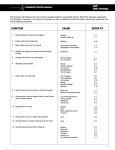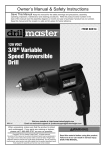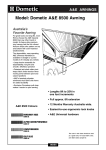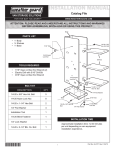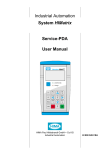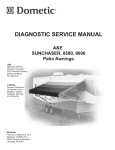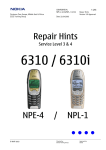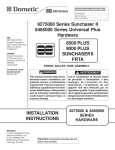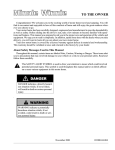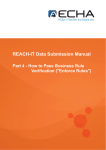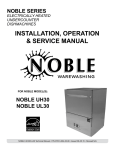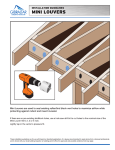Download Model: Dometic A&E 8300 Awning
Transcript
A&E AWNINGS Model: Dometic A&E 8300 Awning A&E innovation leads the field again with the all-new 8300 vinyl patio awning. Its theme is clean simplicity – yet with all the rugged A&E quality RVers have trusted for years. It’s great-looking, long-lasting, easy to operate and very affordable! The canopy fabric is reinforced vinyl in popular Horizon stripe patterns; the weathershield is durable laminated white vinyl. And, like all A&E awnings, the 8300 is stain and mildew resistant, waterproof, washable and fully UV protected. • Lengths 10ft to 16ft in one foot increments A&E Sunchaser 8300 Colours • Full approx. 8ft extension • Simple one-person setup • Sporty coloured canopy top; cool white underneath • Sleek hardware design • Handy ergonomic lock knobs The color in this chart should be used as a guide only. For exact fabric color, see A&E's fabric sample kit. Index ™ USA Index Fabric Roller Tube Assemb Assemblly with . . Square 1™ Har dware Hard CANADA Cambridge, Ontario CANADA N3H 2N7 This Manual should be read and understood before installation, adjustment, service or maintenance is performed. This unit must be installed and serviced by a qualified serviceman. Modification of this appliance can be extremely hazardous and could result in personal injury or property damage. For Service Center Assistance Call: MODEL INST ALLA TION INSTALLA ALLATION INSTRUCTIONS Form No. 3106879.004 1/96 ©1996 The Dometic Corp. LaGrange, IN 46761 (French 3108650.007) Sunchaser 1 INST ALLA TION INSTALLA ALLATION the torsion rod using the 1/4–20 machine screws, nylon washers, and 1/4" locknuts.(FIG. 2A) Align and attach the other end. COVERED BY PATENT 4,524,791 OTHER PATENTS APPLIED FOR FIG. 2A REQUIRED PARTS (Packed with each Hardware Assembly) (2) (2) (8) (2) (2) (2) 1/4–20 Machine Screws 1/4–20 Short Locknuts #14 x 2 Screws #10 Self-Drilling Screws Stop Washers #6 Self-Drilling Screws (1) Door Roller Kit, Containing: (2) #10 Self-Drilling Screws (1) Door Roller (1) Edge Guard Application The A&E Awning is designed and intended for use on motorhomes, mini-motorhomes, 5th wheels and travel trailers with straight sides. IMPORTANT: Read and understand ALL of the following steps before beginning installation. FIG. 2B The Dometic Corporation reserves the right to modify appearances and specifications without notice. Installation of A&E Awnings will at some points, require three people. Use the following procedure to assure a properly installed, and properly functioning awning. FIG. 1A Position Wheel Directly over edge of Door Wheel Above Door 1/4" – 3/8" ENTRY DOOR DO NOT REMOVE the NAIL from the right end at this time and DO NOT attempt to rotate the Safe-T-LockTM Lock Direction Lever until installation is complete. (Lever has been preset in the roll-down position.) (FIG. 2A) 1. Where the A&E Awning is to be mounted above the entry door, the door roller must be installed on the exterior side of the door in the extreme upper corner above the door handle. (FIG. 1A) In addition, if there is a screen door inside the SCREEN regular door, a door edge FIG. 1B DOOR guard must be installed DOOR EDGE on the exterior side of GUARD the screen door, in the extreme upper corner opposite the door hinges. (FIG. 1B) This allows the door roller or the edge-guard (instead of the sharp door corner) to contact the underside of the fabric when the entry or screen door is swung out while the awning fabric is extended low. 3. Remove the left nail only. With both awning arms secured to the Fabric Roller Tube Assembly, and facing the floor, rotate the left arm clockwise as if rolling the fabric up. This takes the torsion pressure off of the nail. Remove the nail by hand and lower the arm to the floor. (FIG. 2B) 4. DO NOT remove the tape or spacer holding the arm and rafter together until the top brackets are installed. Prepare the awning rail to accept the awning roller cover by selecting the end from which the awning shall be fed, then widen that end of the rail with a flat screwdriver and remove burrs. (FIG. 3) With one person grasping each support arm, carefully lift the entire assembly to an upright position. Keeping the two arm assemblies PARALLEL to each other to avoid excessive twisting and possible damage to assembly, walk the awning to the prepared end of the awning rail (FIG. 4A) 2. Carefully lay the fabric roller tube assembly on a clean, well padded "V" trough to prevent fabric damage. Working on the torsion lock end first, insert the arm cap into the arm, position the nail in the end cap to the front of the hardware, align and secure the arm assembly to 2 FIG. 3 BEFORE arm and rafter on each side. Install remaining top mounting bracket using the same procedure. Remove the tape holding the awning arm and rafter together and unhook the travel straps after both brackets are installed. FIG. 4A AWNING RAIL FABRIC ROLLER TUBE ASSEMBLY ARM ASSEMBLIES TAPE FIG. 5B TAPE AFTER A third person is now required to guide the full awning into the awning rail while standing on a stepladder, while the other two walk the entire awning assembly to the desired position. (FIG. 4) 5. Loosen the knobs and extend the arms to the ground. Position the pivot 2 inches above the awning rail. Retighten the knobs so the arms support the awning weight. FIG. 5C PIVOT AWNING RAIL 6. Install Top Mounting Brackets. After the complete awning assembly has been slid into the awning rail, check to be sure that its position allows for solid mounting of the top and bottom brackets and that support arms are in desired location (not restricting use of doors, access doors, etc.). (FIG. 5A) TOP MOUNTING BRACKET DO NOT untape or move the main support arm away from the top mounting bracket and rafter arm. #14 HEX. HD. SCREW #14 HEX. HD. SCREW FIG. 5A TOP MOUNTING BRACKET FIG. 5D AWNING RAIL PIVOT Swing the foot away from the coach as needed to lower the top pivot to the awning rail height. Insert the pivot into the awning rail as shown in FIG. 5B. FIG. 5E Position the top bracket in the top pivot. Alternate slots allow for use with various awning rails and constructions. (FIG. 5C, D, E) Mark the top bracket hole locations. Predrill the two holes using a 3/16" drill bit. The hole should angle downward slightly. (Use 7/32" drill bit if drilling through steel). Install top bracket with two #14 hex. hd. screws (FIG. 5C, D, E). Use clear silicon to seal where the screw enters the coach. The main support arm cap will rest on the top pivot. Check that there is approximately 1/8 inch between the TOP MOUNTING BRACKET #14 HEX. HD. SCREW AWNING RAIL PIVOT 3 7. Installation of Bottom Mounting Brackets Brackets. Position the bottom mounting bracket (FIG. 6) between 66" and 80" below the awning rail, centered on the main arm with the coach level. Always select the position that offers the best supporting structure for mounting the bottom bracket, i.e. mount directly into the floorline, molding, etc. 8. Installation of Stop Washer CAUTION: 1) This step is essential for the proper functioning of all A&E Awnings. 2) The top brackets (FIG. 5) must be bolted tight to the coach to ensure proper stop washer location and proper awning function. FIG. 6 A. Ensure the arm cap is above the rafter pivot. Hold the arm snug to the rafter. Loosen the arm knob slowly so the arm lowers onto the rafter pivot. Raise the inner arm to where the foot is at the bottom of the foot bracket and retighten the knob. (FIG. 7A) FIG. 7A Mark position of bottom bracket so that both holes are positioned over the floorline. Predrill two 3/16" dia. holes through the marked locations. (Use 7/32" dia. if drilling through steel). Secure bracket using two #14 hex head screws. (FIG. 6B). Use clear silicon to seal where the screw enters the coach. Repeat for other side. FIG. 6B B. Lift the weight of the awning with the arm and snap the foot into place. (FIG. 7B) FIG. 7B The bracket must be mounted level. When installing over a molding, A&E Stand-Off Kit, Part No. 3104781, may be used. FIG. 6C 4 C. (Refer to FIG. 7C) 1) Rotate the arm to the coach, holding it against the rafter again. 2) Loosen the rafter knob so the rafter will slide within the arm. FIG. 8 Safe-T-Lock Lever in Roll Up Position FIG. 7C REMOVE NAIL ROLLER TUBE END CAP 10. Securing Awning 10.Securing The fabric must be secured from shifting within the awning rail. Open and close awning a few times to allow for natural self adjustment of awning. Track the strap slightly to one side as it closes to avoid bulging over the extra thickness of material and stretching the fabric. With the awning closed, the fabric will locate itself between the two top brackets. Pull the main arm sideways to the rafter so there is no gap between them. The fabric will move with the roller tube. Measure in 2" from the edge of the fabric and secure by driving a #6 self-drilling screw through the rail and into the fabric rope. (FIG. 9) 3) Loosen the arm knob slowly, letting the arm cap settle onto the rafter pivot. 4) Mark the stop bolt location lightly at the very bottom of the main arm in the center of the adjustable arm. 5) Lift the arm 1 inch and 6) Retighten the arm knob. 7) Install the stop plug with (1) #10 self-drilling screw centered to 1/8" above the marked line. 8) Loosen the arm knob, letting the weight settle onto the stop plug. The main support arm cap should completely clear the main rafter and pivot as it swings toward the vehicle. Repeat for other side. (You may need to push the other arm, rotating the awning to the coach wall). Repeat at other end, hold the main arm against the rafter while securing the fabric. 9. Releasing Pre-Set Tension. FIG. 9 When removing nails, keep hands clear of hardware and roller tube. Springs are under tension and the awning will attempt to close. The nail is found in the roller tube end cap (FIG. 8). Twist the roller tube as if unrolling awning while pulling the nail by hand and discard. Remove wire tie from the Safe-T-Lock™ Lever. Rotate the lever to the roll up position and allow the awning to roll up. The awning should now roll up snugly against the vehicle side. If no tension is felt, check to make sure the Safe-TLock Lever is in the roll-up position. 11. Operate awning according to the Operating Instructions to check that all parts function properly. 12. Re-secure the travel straps. TM 5 SERVICE OFFICE The Dometic Corp. Fabric Roller Tube Assembly with Square 1™ Hardware . 1 OPERATING INSTRUCTIONS Form No. 3106880.002 1/96 (French 3108603.006) ©1996 The Dometic Corp. LaGrange, IN 46761 1 MODEL 8300 Sunchaser TO OPEN Index 4. From the side of either arm assembly, pull sideways on the rafter and slide it to the top of the support arm. Place downward force on main support arm to remove slack from fabric and tighten black adjustment knob on the rafter arm. Repeat for other side. (FIG. 4) 1. Loosen the rafter adjustment lock knobs (located behind the main arm) and unhook the travel straps. (FIG. 1) FIG. 1 FIG. 4 RAFTER ADJUSTMENT LOCK KNOB 5. Reposition the pull strap out of the way by sliding it down the fabric roller tube assembly toward the right (same end as the Safe-T-Lock™). Wrap the strap around the main support arm. (FIGS. 5A & 5B) 2. Locate Safe-T-Lock™ Lever on the right end cap of the fabric roller tube assembly. Place the hook of the pull rod behind lock lever and pull lever forward into the ROLL DOWN position. (FIG. 2) FIG. 5A FIG. 5B FIG. 2 SAFE-T-LOCK LEVER TM 6. To raise awning, grasp arm, loosen knob, and lift the arm assembly. When the desired awning height is reached, retighten the knob. Extend other arm assembly to the same height. (FIG. 6) PULL ROD 3. Insert hook of the pull rod through the loop of the pull strap. Pull the strap outward and completely extend the awning. The awning will stay positioned by itself. (FIG. 3) FIG. 6 FIG. 3 ARM KNOB 2 7. For extended stays and where ground and weather conditions permit, the patio position allows easier access and more usable space (FIG. 7B): 8. CAUTION: Whenever heavy or prolonged rain or wind is anticipated, or you will leave the awning unattended, it is best to close the awning. Damage as a result of weather is not covered by warranty. Lower the awning (reverse Steps in Sec. 6) Grasp the arm and support the awning weight. Push on the thumb latch and remove the foot from the bracket. (FIG. 7A) FIG. 8 Place the support arm down vertically on the ground and adjust the support arm height. (FIG. 7B) Accessory hold-down stakes should be installed through the holes on the awning foot to secure the awning in case of wind. (FIG. 7C) FIG. 7A TO CLOSE 1. FROM PATIO POSITION Remove the stakes from the awning foot and swing the support arm up to the bottom mounting bracket. Repeat on other side. (FIG. 1) FIG. 7B FIG. 7C FIG. 1 2. FROM VEHICLE MOUNTING POSITION: Grasp the main arm, loosen the arm knob and lower main support arm down to the stop plug. (FIG. 2) CAUTION: DO NOT DRIVE THE STAKES "HOME" AS IT WILL BE DIFFICULT TO PULL THEM OUT AND MAY DAMAGE THE AWNING FOOT. FIG. 2 Repeat this step on the other side to complete the patio position setup. ARM KNOB 3 3. To release the rafter arm, loosen black adjustment knob on the rafter arm and lift up on the slider catch, located under the slider. Pull sideways on the rafter and slide it to the bottom of the main arm. DO NOT retighten adjustment knob at this time. (FIG. 3) 5. Tighten the four adjustment knobs and secure the travel straps. FIG. 3 TRAVEL STRAP The awning is now ready for travel. OWNER MAINTENANCE HELPFULHINTS FORAWNING CARE 4. Prepare fabric roller tube assembly for roll-up. While pulling down on the pull strap or while, from the bottom, turning the entire roller tube toward you slightly, flip the Safe-T-Lock™ Lever into the ROLL UP position. 2 Whenever the awning is wet while rolled up, as soon as conditions allow, roll it out and let it dry before rolling it up again. This will help prevent mildew and rotting. CAUTION: DO NOT release the awning as it is now under tension and could snap back against the vehicle side. 2 Always make sure the awning is extended high Hold the roller tube down and slide the pull strap to the middle of awning. Using strap for control of speed and even roll-up, allow awning to return to the vehicle side. (FIG. 4) enough before opening entry door. 2 WHEN TO GET MORE HELP: If malfunctions occur that cannot be corrected by reviewing this user's guide, contact a qualified Dometic service technician. NOTE: Wind the strap diagonally as the awning rolls up to avoid creating a bulge and stretching the awning fabric. Please note: A slight "travel line" may appear where the door roller contacts the awning fabric. This is considered normal and does not affect the integrity of the awning. FIG. 4 4 A&E AWNINGS - SPARE PARTS Model: Dometic A&E 8300 Awning 122 A&E AWNINGS - SPARE PARTS Model: Dometic A&E 8300 Awning Item No. 1 2 3 4 10 11 12 8271003.402B Part No. Description Main Arm A1 Handle. Iift A2 Rivet A4 Shim, lift base A5 Kit, slider catch Arm, asm. adjustable B1 Foot diecast (2 req.) (2 req.) (pair) (2 req.) C1 Rivet, semi-tube 5/16"x2.59 C2 Rivet, semi-tube 1/4"x2.56 Rafter asm., main (2 req.) D1 Bracket asm., top D2 Rivet, semi-tube D3 Bumper. rubber D4 Latch, travel (2 req.) Rafter asm., secondary (2 req.) E1 Slider E2 Rivet, semi tube 3/ 6” x 1.45 SS Knob, 5-point (2 req.) Nut, special (2 req.) Rod, EZ-pull 3104502.426B 830644 308171.020 ---830472.002 830466.516B 3108708.342 (Old) 3108708.042 (New) 143002.059 143002.058 830295.542B 3108119.003M 143002.053 141031 3105278.026 830463.512B 830463 143002.055 3105421.014 3104652.007 830152.102 123 A&E AWNINGS - SPARE PARTS Model: Dometic A&E 8300 Awning Item No. F2 F3 F4 F5 F6 F7 F2 + F3 Description Bracket, bottom Kit, hardware, includes Washer. split Screw cap. Hex 1/42 Screw *6-20 Screw #10-24 Nut lock Washer, stop Screw #14 x 2.0 Screw #14 x 3.0 Screw 1/4-20 Cap, arm Washer, nylon Nut, lock Universal Hardware Kit Part No. (2 req.) (2 (2 (2 (2 (2 (2 (4 (4 (2 (2 (2 (2 (2 req.) req.) req.) req.) req.) req.) req.) req.) req.) req.) req.) req.) req.) 124 3104653.005 3104852.003 3104176.114 3107942.009 309513.054 3106825.007 3104125.020 Kit 3107942.009 A&E AWNINGS - SPARE PARTS Model: Dometic A&E 8300 Awning ITEM PART No. No. DESCRIPTION 1 3 4 5 Kit pull strap 94.5" Torsion Asm. Right-hand Torsion Asm. Left-hand Roller Tube 10' Roller Tube 11' Roller Tube 12' Roller Tube 13' Roller Tube 14' Roller Tube 15' Roller Tube 16' Fabric Asm. 10' Fabric Asm. 11' Fabric Asm. 12' Fabric Asm. 13' Fabric Asm. 14' Fabric Asm. 15' Fabric Asm. 16' 6 940001 3108018.080 3108018.098 3108346.010 3108346.011 3108346.012 3108346.013 3108346.014 3108346.015 3108346.016 R3105699 (Colour R3105699 (Colour R3105699 (Colour R3105699 (Colour R3105699 (Colour R3105699 (Colour R3105699 (Colour Code) Code) Code) Code) Code) Code) Code) .106 .114 .122 .130 .148 .155 .163 Colour Code: SEE INDEX FOR CODES AW = Burgundy AV = Blue BE = Coffee EH = Pewter Dometic A&E AWNINGS - SPARE PARTS Model: Dometic A&E 8300 Awning Part No.: 3108018.080 TORSION ASSEMBLY – RIGHT-HAND ITEM PART No. No. DESCRIPTION A2 A3 A4 A6 A10 Asm., cap, end Pin, spring 3/16” x 1” (2 req.) Spring, torsion lock Disk, lock Spring, torsion, right-hand 3108017.009 3104664.044 3105695.005 3105691.004 3105687.002 Part No.: 3108018.098 TORSION ASSEMBLY – LEFT-HAND ITEM PART No. No. DESCRIPTION C2 C7 C12 Asm., cap, end Pin, spring 3/16” x 1” Spring, torsion, left-hand 3108017.009 3104664.044 3105687.010 Index 8300 8500 9000 REPLACEMENT OF TORSION ASSEMBLY 1. Insert the leg of the idler opposite the torsion spring screw and washer over the seamed groove of the roller tube. See FIG. 10. NOTE: The idler leg opposite the torsion spring screw has a triangle shape. FIG. 10 2. Installation of a new roller tube may require a notch cut in the side of the groove away from lock lever for each poly rope. See FIG. 11. NOTE: Insert torsion idler into roller tube before the poly rope is stretched. See Section E. Step 1. 3. Use pliers to stretch the poly rope 1/4" – 1/2" and tuck it into the notch and place off to the side. See FIG. 13A13G. Repeat Steps 1 and 2 on opposite end. FIG. 11 FIG. 12 FT LE RIG H T WIND TO ADD TORSION CAP A ROLL UP ROLL DN FT LE RIG H T WIND TO ADD TORSION CAP B ROLL UP The left-hand end cap is always positioned with the open notch over the open groove. See FIG. 13G. 5. Mark the location of rivet holes in the end cap on roller tube. Drill 3/16" hole. Remove any drill burrs from inside roller tube. CAP C 6. Attach end cap to roller tube with two 3/16" x 3/8" pop rivets. Repeat on opposite end. 5 ROLL DN 4. Slide torsion assembly into roller tube. Identify the end cap "A", "B" or "C" (refer to FIG. 12). Position the SafetyT-Lock™ Lever as shown in FIGS. 13A–13F. FIG. 13A RIGHT-HAND END CAP “A” Fabric without hemmed edge Cut Poly Rope flush with end of tube See Fig. 11 ROLL UP Open Groove ROLL DN WIND TO ADD TORSION FT LE RIG HT Place open notch in alignment with open groove Valance Trim Poly Rope leaving sufficient length to tuck in place behind the open groove RIGHT-HAND END CAP “A’ Fabric edge folded and hemmed Place open notch in alignment with fabric groove Cut Poly Rope flush with end of tube FIG. 13B LEF See Fig. 11 T RIGHT TO N D SIO IN W TOR D AD LL RO UP Open Groove LL RO D N Valance Trim Poly Rope leaving sufficient length to tuck in place behind the open groove RIGHT-HAND END CAP “B” Place open notch in alignment with fabric groove Fabric edge folded and hemmed Cut Poly Rope flush with end of tube HT See Fig. 11 W ADD IND TO TOR SIO N ROL L DN LEFT RI G FIG. 13C ROL UP L Open Groove Valance 6 Trim Poly Rope leaving sufficient length to tuck in place behind the open groove RIGHT-HAND END CAP “B” Fabric without hemmed edge Cut Poly Rope flush with end of tube ROLL DN See Fig. 11 ROLL UP FIG. 13D Trim Poly Rope leaving sufficient length to tuck in place behind the open groove Open Groove WIND TO ADD TORSION FT LE RIG HT Place open notch in alignment with valance groove Valance RIGHT-HAND END CAP “C” Place open notch in alignment with fabric groove Cut Poly Rope flush with end of tube Fabric without hemmed edge FIG. 13E See Fig. 11 Trim Poly Rope leaving sufficient length to tuck in place behind the open groove Open Groove Valance RIGHT-HAND END CAP “C” Cut Poly Rope flush with end of tube Fabric edge folded and hemmed FIG. 13F See Fig. 11 Open Groove Place open notch in alignment with Open groove Valance 7 Trim Poly Rope leaving sufficient length to tuck in place behind the open groove FIG. 13G LEFT-HAND END CAP Fabric Trim Poly Rope leaving sufficient length to tuck in place behind groove The Left-Hand End Cap is always placed with open notch in alignment with open groove See Fig. 11 Valance Open Groove F. WINDING TORSIONS AWNING LENGTH 1. Insert torsion winding tool into torsion rod. See FIG. 7. 8' 9' 10' 11' 12' 13' 14' 15' 16' 17' 18' 19' 20' 21' AND ABOVE 2. Always have the speed wrench handle at the 6 O-clock positions and turn towards the side of the coach. Left hand end cap is turned clock-wise and right hand end cap is turned counter-clock-wise to add tension. FIG. 14 * ROLLED UP TURNS * EXTENDED TURNS* 5 5 5 5 5 6 6 7 7 9 9 10 10 10 11 11 11 11 11 12 12 13 13 15 15 16 16 16 Add 6 additional turns to torsion spring when awning is fully extended. 3. After torsion spring is wound to proper number of turns, insert a steel pin in the end cap to prevent rapid spin-off when reinstalling on coach. See FIG. 3, Page 2. NOTE: Right hand torsion must have Safe-T-Lock™ lever in the roll-down position. 4. Reinstall awning per the Operating and Installation Manual. If the awning is not removed from the coach, reverse disassembly procedure. 8 A&E Patio Awnings DIAGNOSTIC SERVICE MANUAL This program will address the most common system problems associated with the A&E Patio Awnings supplied by The Dometic Corporation. Our intent is to provide you with a guideline of checks to make, should you encounter one of the following symptoms. SYMPTOM CAUSE REFER TO 1. Black adjustment knob will not tighten Nutsert Washer Stack-up 1.1 1.2 2. Fabric leaks at the roller tube Stitches 2.10 3. Main support arms will not extend Push button assembly Adjustable arm assembly 1.3 1.4 4. Awning has bulges or wrinkles where pull strap rolls up Operation 3.1 5. Awning fabric will not roll up straight Fabric position Out of square 2.1 2.2 6. Weatherguard wrinkled Seams Vehicle sidewall Tek screws Weatherguard Out of square 2.4 4.2 2.12 2.3 2.2 7. Fabric does not hang well Out of square Tube deflection Tek screws Seams Vehicle sidewall Stitches 2.2 2.6 2.12 2.4 4.2 2.10 8. Must lift main arm(s) to open or close the awning Stop plug Bottom mounting brackets 1.7 1.6 9. Awning arm(s) stay up against side of coach when trying to open awning Top mounting bracket Fabric position Operation Travel lock 1.5 2.1 3.1 3.4 10. Awning will not roll up Rafters Cam Black adjustment knob Torsions 1.8 2.9 1.9 2.8 11. Awning will not stay in rolled down position Cam 2.9 12. Awning billows out when traveling down the road Cam 2.9 13. Awning stops at guard when rolling up Rafters Stop plug Operation Torsions Awning rail Top mounting brackets 1.8 1.7 3.2 2.8 4.3 1.5 1 Diagnostic Service Manuals A&E Patio Awnings SYMPTOM DIAGNOSTIC SERVICE MANUAL CAUSE REFER TO 14. Water leaks through guard Operation Guard Tube deflection 3.3 2.5 2.6 15. Water drips down the side of coach Awning rail Rubber seal 4.1 2.7 16. Water leaks through fabric Fabric 2.11 SECTION 1 1.2 WASHER STACK-UP HARD WARE COMPONENTS HARDW Washer stack-up merely means the proper positioning of the washers on the stud of the black adjustment knob. Remove the knob and check for proper washer position. The plastic washer should be against the main rafter, and backed by the metal washer for stiffness. If the stack-up is not proper it should be corrected. 1.1 NUTSERT OR SPECIAL NUT The nutsert is simply a threaded fastening device used to tighten down the black adjustment knob. If the knob will not tighten, first remove the secondary rafter assembly from the hardware. Turn the knob to determine if the nutsert is stripped or NUTSERT spinning. If so, replace the nutsert. If you cannot turn the knob it will be necessary to replace both the nutsert and the black adjustment knob. On some arm assemblies the nutsert has been replaced with a SPECIAL NUT NUT. If the knob will not tighten, first separate the rafter assembly. Turn the knob to determine if the special nut is stripped. If so, replace the special nut. If you cannot turn the knob, it will be necessary to replace both the special nut and the back adjustment knob. SPECIAL NUT SECONDARY RAFTER PLASTIC WASHER METAL WASHER ADJUSTMENT KNOB 1.3 PUSH BUTTON ASSEMBLY The push button assembly locks the main support arm to the adjustable arm assembly and controls the height of the awning in the open position. To check it, open the awning to full extension. Look inside the main support arm, and activate the push button to see if the locking pin is moving in and out of the hole in the adjustable arm assembly. If the locking pin does not move, or has been SD 66 BS RIVET (3/16 DIA. POP RIVET) COMPRESSION SPRING LIFT HANDLE LOCK BUTTON 3/16" X 1/4" GRIP ALUMINUM POP RIVET BUTTON LOCK BUTTON RETAINER MAIN SUPPORT ARM NOTE NOTE: The special nut could be a large hex nut as well as the one shown. 2 SD 66 BS RIVET (3/16 DIA. POP RIVET) #8—32 HEX NUT A&E Patio Awnings DIAGNOSTIC SERVICE MANUAL broken off, the push button assembly must be replaced. At times the lock pin of the push button assembly can break off and jam between the push button housing and the adjustable arm assembly, making it difficult to extend the main support arm. 1.4 ADJUSTABLE ARM ASSEMBLY The adjustable arm assembly allows for telescoping height adjustment of the main support arm, and it connects to the bottom mounting bracket to support the weight of the awning. If the main support arm cannot be extended freely, the adjustable arm assembly should be checked. Remove the adjustable arm assembly and check for nicks, burrs, bends or twists. If any deflection is noted, the adjustable arm assembly must be replaced. For ease of operation apply GO-EASY, a special lubricant. LIFT HANDLE ARM ASSEMBLY ADJUSTABLE ARM NOTE: GO-EASY is available from your distributor. 1.5 TOP MOUNTING BRACKETS The top mounting bracket supports the main rafter assembly to hold the awning in the open extended position, and allows the rafter to pivot into the “C” channel of the main support arm. Each top mounting bracket should be mounted directly over the awning rail so the screws go through the “C” portion of the rail. TOP MOUNTING BRACKET On the Series 9000 awning the top mounting bracket can be mounted lower when possible. If the top mounting bracket is mounted above center of the awning rail, the aluminum guard may not cover the fabric completely in the closed position. If this is the case, relocate the top mounting bracket accordingly. The top mounting brackets have slotted holes for the mounting screws, allowing them to be adjusted side to side. To adjust the brackets, close the awning and sight down the main support arm and the main rafter. The clearance on each side of the rafter should be approximately 1/4 inch. If clearance is not appropriate, adjust the top mounting bracket(s) as necessary. 1.6 BOTTOM MOUNTING BRACKETS The bottom mounting brackets are screwed to the floor line of the unit, and they support the weight of the BOTTOM MTG. BRACKET awning. They INSERT also provide a BOTTOM BOTTOM MOUNTING quick release MOUNTING BRACKET BRACKET to set up the SPACER #14 X 2-1/2" HEX. HD. SCREWS awning in the patio position. If a bottom mounting bracket settles, sags, or becomes loose it can reduce the clearance between the top casting of the torsion and the extension of the top mounting bracket, making operation difficult. Check the bottom mounting bracket for looseness or settling, and tighten or reposition it accordingly for proper operation. 1.7 STOP PLUG The stop plug is a mechanical stop that supports the main arm when opening and closing the awning. It controls the clearance between the top casting of the torsion to the extension of the top mounting bracket. This clearance should be 1/4 inch to 1 inch. To adjust the clearance, raise or lower the stop plug as needed. On the 9000 and 9500 Series awning the clearance should be kept to a minimum for best operation. TOP VIEW OF MAIN SUPPORT ARM AND RAFTER MAIN SUPPORT ARM RAFTER 1/4" CLEARANCE, EACH SIDE FROM TOP TO BOTTOM OF ARM ASSEMBLY 3 A&E Patio Awnings DIAGNOSTIC SERVICE MANUAL Attempting to open the awning without first loosening the black adjustment knobs can damage the slider of the secondary rafter, making it difficult to open the awning. TOP MOUNTING BRACKET AWNING RAIL SECTION 2 FABRIC R OLLER TUBE ASSEMBL Y (FR TA) ROLLER ASSEMBLY (FRT CLEARANCE EXTENSION 2.1 POSITION For the awning to operate properly the fabric must be positioned properly in the awning rail and on the roller tube. Open the awning and check the position of the fabric between the top mounting brackets. If the fabric is not centered, remove the tek screws, center it, and replace the screws. MAIN SUPPORT ARM STOP PLUG MAIN ARM STOP PLUGS #10 LOCK NUT 3/16" DIA. HOLE CLOSEST TO MAIN ARM CLEARANCE FROM FABRIC TO END CAP #6 X 1/2" TEK SCREW 2" 1.8 RAFTERS The rafters telescope from the top mounting brackets to the main support arms to provide tension on the fabric in the full open position. If the rafters are bent or twisted, this will hinder the operation of the awning. Open the awning and remove the secondary rafter from the main support arm. Now sight down the main and secondary rafters and check for any bends, twists or deflection. If one or the other rafter is not true it should be MAIN RAFTER replaced. SECONDARY RAFTER SLIDER 1.9 BLACK ADJUSTMENT KNOB The black adjustment knob tightens the secondary rafter to the main rafter to keep the fabric taut in the full open position. When closing the awning, the knob should not be tightened down until after the awning is rolled up and the travel lock is engaged. 4 AWNING RAIL TOP BRACKET VINYL FABRIC When the fabric is properly positioned, next check the position of the fabric on the roller tube. The clearance from the end cap of the torsion assembly to the edge of the fabric must be the same on each end. If it is not, adjust the fabric on the tube as necessary. On the Elite 9000 and 9500 awning the fabric is held in place to the weatherguard with 1/8" pop rivets. Check the position of the fabric at each end of the weatherguard.. If the fabric has shifted, remove the pop rivets, center the fabric and re-rivet. 2.2 SQUARE If the fabric on the awning is out of square, it could cause the fabric to telescope in one direction when rolling up, or to not hang properly in the open position. A&E Patio Awnings DIAGNOSTIC SERVICE MANUAL To check fabric for square, measure from the top right hand corner of the fabric (not the weatherguard) to the bottom left hand corner at the poly rope. Now measure from the top left hand corner to the bottom right hand corner as shown below. AWNING RAIL WEATHER GUARD FABRIC 1ST POLY ROPE ROLLER TUBE DISTANCE FROM FABRIC TO END CAP (SAME ON EACH END) In this check, the difference of the two dimensions should be no more than one inch. If it is more, the fabric is out of square, and replacement would be necessary. The seams of the vinyl awning are electronically welded together with a heat seal. The welded seams are the strongest part of the fabric. If the fabric has wrinkles or sags, it may be due to improper seam welding. A close inspection may reveal the seams to be the source of the problem. If so, fabric replacement would be needed. Whenever wrinkles are detected in the fabric, stretching of the weatherguard should be performed before the fabric is condemned for bad seams. See 2.3 for stretching instructions. 2.5 ALUMINUM GUARD The aluminum guard on the Elite 9000 and 9500 is the last 15 inches of the awning that encloses it in the rolled up position, and protects the woven acrylic fiber fabric from the environment and elements. On 9000 awnings that have the hinge slat which fits into the awning rail: When the awning is fully extended, the aluminum guard should have an arch of at least 2 inches. The arch helps water to run off rather than between the sections of the guard. NOTE NOTE: The aluminum guard is not waterproof. 2.3 WEATHERGUARD The weatherguard is the last 15 inches of the awning that encloses the fabric in the rolled up position. It protects the striped fabric from the environment and elements. The weatherguard is a heavy 17 oz. vinyl fabric. #6 X 1/2" TEK SCREW SECOND SLAT 2" MIN. 2" TOP SLAT/HINGE ASSEMBLY BOTTOM SLAT ELITE 9000 SHIELD ASSEMBLY AWNING RAIL TOP BRACKET VINYL FABRIC When the vinyl weatherguard or fabric has excessive wrinkles, it will be necessary to stretch the weatherguard or fabric. Open the awning and allow the fabric to warm up. Remove one Tek screw, grasp the weatherguard, stretch it, and resecure the screw. Repeat this procedure for the other end, making sure to stretch each side an equal distance, keeping the fabric centered between the top mounting brackets. Close and reopen the awning three times. If wrinkles are still present, repeat the above stretching procedure. This may have to be done 4 or 5 times before all wrinkles disappear. To check the aluminum guard for proper arch, open the awning to full extension, making sure the fabric is taut. Hold a flat edge to the bottom of the guard and measure from the flat edge to the inside of the arch at its highest point. If the measurement is less than 2 inches, the guard should be replaced. On both 9000 and 9500 awnings that DO NOT have the hinge slat slat: The arch of the aluminum guard is not important as the fabric goes under the aluminum guard and attaches the awning to the awning rail. 2.6 ROLLER TUBE 2.4 SEAMS 5 A&E Patio Awnings DIAGNOSTIC SERVICE MANUAL 9000 WITH HINGE SLA T SLAT E C D D D A - VINYL STRIP B - HINGE SLA T SLAT C - TOP SLA T SLAT D - MAIN SLA T SLAT E-A WNING RAIL AWNING VINYL STRIP "A" D D INSTALL A 1/8" POP RIVET EACH END HINGE SLAT "B" TOP SLAT "C" VIEW RH END E 5/16" CHANNEL BOTH ENDS C MAIN SLAT "D" VIEW RH END D D D 5/16" CHANNEL INSTALL TOWARD CANOPY 1/4" CHANNEL INSTALL TOWARD AWNING RAIL D 3/8" CHANNEL FOR VINYL STRIP "A" HINGE SLAT "B" D 1/4" CHANNEL INSTALL A 1/8" POP RIVET EACH END 9000 AND 9500 WITHOUT HINGE SLA T SLAT 6 VINYL STRIP "A" 5/16" ROD IN AWNING RAIL A&E Patio Awnings DIAGNOSTIC SERVICE MANUAL The roller tube is a 3-1/2 inch diameter tube. It has three symmetrical grooves to retain the poly ropes of the awning fabric. If the fabric appears to have more than normal sag, the roller tube deflection must be taken into consideration. Depending on the length of the awning, the roller tube can deflect from one to five inches with the awning in the open position. Installing a tension rafter will usually remove 80 per cent of sag and roller tube deflection. All awnings 22 feet and longer should be installed with heavy duty hardware which includes a center tension rafter, a center supporter, and heavy duty adjustable arm assemblies. If the roller tube is bent, it will bounce up and down when opening and closing the awning. On the 9000 Series this can cause the aluminum guard to leak, because the guard assembly may not be tight. provides tension on the roller tube to roll the awning up into the travel position. The right hand torsion end cap contains a cam assembly which prevents the awning from billowing or unrolling during travel. It also allows one-person set-up of the awning by preventing rollback. When difficulties are experienced in rolling the awning up, the tension on the torsion should be checked. In #6 MACHINE SCREW TOP CASTING WASHER END CAP WITH ASSY. 3/16" POP RIVETS 2.7 RUBBER SEAL On the 9000 Series awning(see Section 2.5), an extruded black rubber seal is located at the awning rail of the coach. The seal slides into the metal hinge which connects the aluminum guard to the awning rail. This seal is designed to prevent water from running down the side of the coach. To check, inspect the full length of the seal for proper positioning, and for cuts, tears or wrinkles. If any of these problems are found, the seal should be repaired or replaced. On some units it may be necessary to silicone seal the lips of the rubber seal to the awning rail and the top slat of the aluminum guard as shown , to prevent water from running down the side of the RV. TORSION SPRING/ STABILIZER ASSEMBLY IDLER SLEEVE STABILIZER TORSION ROD 2.8 TORSION ROLLER TUBE SILICONE SEALANT TOP SLAT HEX LOCK NUT FABRIC RUBBER SEAL most cases adding a few turns of torque to each end will correct the problem. If all tension has been lost, refer to the following chart and apply the specified number of turns as indicated. This must be done with the awning extended two feet away from the coach. . METAL HINGE AWNING RAIL 9000 AWNINGS WITH HINGE SLAT The torsion assembly has a wound coil spring which 7 A&E Patio Awnings DIAGNOSTIC SERVICE MANUAL TORSION ASSEMBLY TORQUE SPECIFICATIONS Number of Turns MODEL NUMBER 5000 7000 6 6 6 6 6 6 7 7 8 8 10 10 11 11 11 12 12 12 12 8 8 8 8 9 9 10 10 12 12 13 13 13 - Awning Length (Ft.) 8 9 10 10' 8" 11 12 13 14 15 16 16'6" 17 18 19 19'6" 20 21 22 23 24 25 1234567 1234567 1234567 1234567 7500 8000 8500 9000 9500 Grande Pavillion 8 8 8 8 8 8 9 9 10 10 12 12 12 13 13 13 13 12345678901 12345678901 14 12345678901 12345678901 12345678901 14 12345678901 12345678901 14 12345678901 12345678901 14 12345678901 12345678901 6 6 7 7 8 8 8 9 9 See Spring Indentification Chart for No. of Turns AWNING RAIL TOP CASTING RIGHT HAND SIDE (VIEWED FROM FRONT) AWNING RAIL TOP CASTING LEFT HAND SIDE (VIEWED FROM REAR) When winding the torsion, be sure to wind in the proper direction. SEVERE INJURIES CAN RESULT FROM THE SPINNING TOP CASTING. USE VISE GRIPS® (NEVER BARE HANDS) TO GRASP TOP CASTING WHILE LOADING TORSION. Note: Rewinding must be done with the Awning Fabric extended two feet away from the coach. 2.9 CAM The cam assembly locks the roller tube from turning in 8 SPRING IDENTIFICATION CHART Standard Wire Dia. Heavy Duty .120 .140 RH Painted red cap end and no paint on stabilzier end. Painted red cap end and white on stabilzier end. LH No paint on either end. Painted white on cap end and no paint on stabilizer end. Length 22' 23' 24' 25' TURNS OF TENSION 14 14 14 14 8 8 8 8 one direction or the other according to which way the cam lock lever is flipped. To check the cam lock on the A&E awning, unlock the main support arms. Hook the pull rod into the pull strap and try to open the awning. Be sure the cam lock lever is in the roll-up position. If the roller tube rotates 1/2 turn or more the cam lock must be repaired or replaced. To check the roll-down position of the cam lock, open the awning to full extension. Grasp the roller tube with your hands and try to turn the tube in the direction it will roll up. If the tube can be rotated 1/2 turn or more the cam lock must be repaired or replaced. 2.10 STITCHES The side hems and poly ropes of the awning are stitched in with a sewing machine. At times the stitches can allow water to leak through to the inside of the roller tube. On vinyl awnings the stitches should be sealed with seam sealer, available at sporting goods stores. This will stop the water from running down the inside of the roller tube. For the woven acrylic fabric of the 9000, 9500 Series awning, Acrylife is an approved sealant. When sewing in the poly ropes of the fabric, if a straight line is not followed it could cause the fabric to hang A&E Patio Awnings DIAGNOSTIC SERVICE MANUAL improperly. A close inspection of the stitching could reveal the cause of a sag or pucker. 2.11 FABRIC A. 9000 AND 9500 The awning fabric is woven acrylic, not vinyl. It is water resistant but not waterproof. Once a year it should be cleaned with Canopy-Clean and resealed to maintain its water resistance. Acrylife is an approved sealant for the 9000, 9500 fabric. Follow the directions for application of Canopy-Clean and Acrylife. If the pull strap is rolled up at one end of the awning, it can cause the fabric to telescope in that direction during roll-up, and create a bulge or wrinkles at that end. This could cause the awning arm to stay against the side of the coach when trying to open. 3.2 CLOSING NOTE: Avoid touching the underside of the awning fabric when it is wet, as this breaks the surface tension of the water causing it to seep through. PULL STRAP B. 8500 AND GRANDE PAVILLION The awning fabric is vinyl. It is waterproof. Once a year it should be cleaned with Canopy-Clean and treated with Vinyl Formula 201 to protect and extend the life of the fabric. Follow the directions for application for CanopyClean, and Vinyl Formula 201. Contact your distributor for these products. 2.12 TEK SCREWS The Tek screws are the two screws installed through the awning rail of the coach. They keep the aluminum guard from shifting in the awning rail. On vinyl and some acrylic awnings (see Sec. 2.5) they keep the fabric from shrinking with age. If one Tek screw is missing, the fabric will pull toward the remaining Tek screw causing the fabric to wrinkle. #6 X 1/2" TEK SCREW 2" On the 9000 and 9500 Series, when rolling up the awning, the roller tube assembly should not be slowed down before reaching the aluminum guard. This could cause the roller tube to stall at the guard. 3.3 TAUTNESS On 9000 Sereis awnings that utilize a hinge slat (see Sec. 2.5): To minimize water leakage through the aluminum guard, the fabric must be taut when the awning is extended. This will keep the sections of the aluminum guard tight against each other. Before tightening the black adjustment knob, be sure to apply enough downward force on the main support arm to pull the fabric taut. 3.4 TRAVEL LOCK The travel lock must be fully released before trying to open the awning. SECTION 4 AWNING RAIL MAIN SUPPORT ARM TOP BRACKET FABRIC UNLOCK TRAVEL LATCH MAIN SUPPORT ARM LOCK TRAVEL LATCH SECTION 3 OPERA TION OPERATION 3.1 PULL STRAP When closing the awning the pull strap must be rolled up at an angle from the center of the roller tube. This will keep the awning from telescoping forward or rearward, and will prevent a bulge from forming in the area where the strap is rolled up. 9 A&E Patio Awnings AWNING RAIL 4.1 LEAKAGE When water drips down the side of the coach, the seal between the coach and the awning rail must be checked. If improper seal is detected, reseal the awning rail. 4.2 STRAIGHT Before condemning the fabric for sags or wrinkles, the awning rail should be checked. Open the awning and sight down the rail to see if the rail or sidewall varies up, down, inward or outward. This must be taken into consideration when checking a fabric. DIAGNOSTIC SERVICE MANUAL There are three types of awning rail used in the RV industry. Of these, type A and B (see below) are acceptable for use on the 9000 Series awning that utilizes a hinge slat (see Sec.2.5) . Type C should never be used on the 9000 Series that utilizes a hinge slat (see Sec. 2.5) as it could cause a binding problem on the aluminum guard assembly, but it is acceptable on the vinyl awnings. A B C OPENING OUTWARD OPENING UPWARD OPENING DOWNWARD 4.3 TYPE 10





























